One of the most crucial jobs you have as a parent is keeping your children safe in the vehicles.
The research shows that thousands of children lose their lives every year or get injured in car crashes.
The proper use of car seats will prevent this.
However, there are so many car seats on the market, and parents are overwhelmed, making it challenging to pick the right seats.
So, if you are parents-to-be, please, take your time and learn how to properly install a car seat in your vehicle so that you can drive your baby from hospital to your home safely.
Of course, the seats must match your children's needs, development, growth, age, and size.
And how to achieve all this?
Read below all about car seat laws and regulations.
Table of Contents
- Car Seat Laws Reduce the Risk on the Road
- Car Seat Laws & The Stages
- Fifty States - Fifty Laws & Regulations
- Young Children & Rear-Facing Seats FAQs
- 1. Why is riding rear-facing the safest way for young children to ride?
- 2. Considering a convertible car seat for a newborn baby?
- 3. What car seats fit a premature or low birth weight baby best?
- 4. When can my baby ride forward-facing?
- 5. How do I know when my child has outgrown his/her infant seat?
- 6. I have a child who is big enough now for a convertible seat. What do I need to know?
- Preschoolers & Forward-Facing Seats FAQs
- Children & Belt-positioning Booster Seats FAQs
- Older Kids & Seat Belts FAQs
- Correct Installation FAQs
- 1. How do I know my child restraint may be incompatible with my vehicle or improperly installed?
- 2. My car seat moves more than one inch side-to-side even after I've tightened the seat belt. Should I buy and use one of those seat belt tightening devices?
- 3. I've heard that most car seats are not used correctly. Where can I get my child's car seat checked?
- Other FAQs
- 1. I have a child with special medical needs. Where can I learn more about securing my child in the car?
- 2. What about air bags?
- 3. I can't afford a child car seat or booster. Is there somewhere I can get help?
- 4. I've lost the locking clip that came with my car seat. Where can I get another one?
- 5. Are you Pregnant?
- Important Notes When Setting the Car Seats
Please Click on Your State Below
OR Click on Your State Below
Alabama – Alaska – Arizona – Arkansas – California – Colorado – Connecticut – Delaware – Florida – Georgia – Hawaii – Idaho – Illinois – Indiana – Iowa – Kansas – Kentucky – Louisiana – Maine – Maryland – Massachusetts – Michigan – Minnesota – Mississippi – Missouri – Montana – Nebraska – Nevada – New Hampshire – New Jersey – New Mexico – New York – North Carolina – North Dakota – Ohio – Oklahoma – Oregon – Pennsylvania – Rhode Island – South Carolina – South Dakota – Tennessee – Texas – Utah – Vermont – Virginia – Washington – West Virginia – Wisconsin – Wyoming
Car Seat Laws Reduce the Risk on the Road
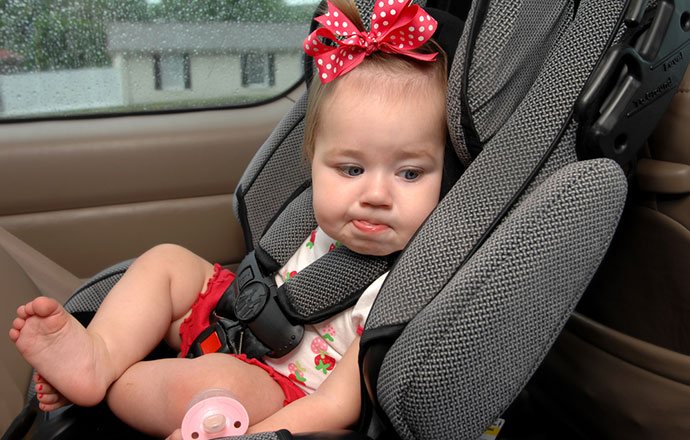
You may already know those car accidents are the leading cause of death and injuries among the USA's youngest population.
Some researches indicate that more than 100,000 kids were injured in years behind, and around 650 lost their lives.
Horrible facts!
But, that's not the end since approximately 35% of them were not buckled up correctly.
As you can see, the situation is alarming, and we can ascribe it either to the parents' neglect or the mild laws.
The use of the car seats reduce the risk of possible injuries in accidents up to 82%, compared with using the seat belt system alone.
Further, the use of the boosters for kiddos between 4 and 8-year-old, prevents the high risks of severe injuries up to 45% when compared with seat belt use alone.
Unless you want this, my advice as a safety technician is to comply with the laws and obey the regulations; otherwise, inattention may have fatal consequences.
Car Seat Laws & The Stages
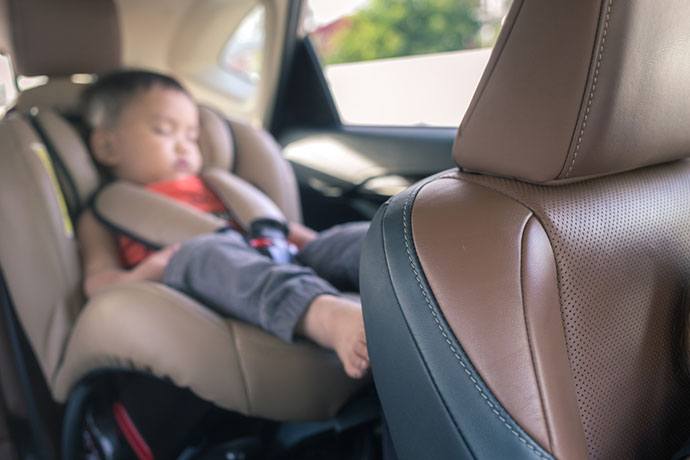
In all fifty states, you'll find the regulations on how to keep your children safe and protected, which car seats to use, and how to install them properly.
The minor differences might occur in terms of little details; however, the main points are the same.
So, let's see the main stages for every child and car seat since you must make sure they use the proper seat for their age, size, weight and development, and the appropriate installation process.
1. Rear-facing car seats
It's a must to use these seats for children between zero to 2 and 4 years old.
To have the ultimate protection, infants and toddlers must buckle in these seats in the back of your motor vehicles until they grow enough and reach the maximum weight limit of the car seat.
Of course, you must check the weight and height limits in the car seat manual and labels.
2. Forward-facing car seats
After your child has outgrown the rear-facing seat, it's time they used forward-facing seats.
The most suitable age for forward-facing mode is a minimum of five years; however, if your child has surpassed the previous seat, you can buckle up them in the next car seat.
But, you must also check the weight and height limit on the car seat labels or study in the instruction manual for more detailed rules and recommendations.
3. Booster car seats
After your little ones outgrow the forward-facing car seats, it's time for a new level.
We talk about booster seats (high back, backless, or harness) for maximum safety and protection.
The most matchable years are between 4 and 8, but if your kids are increasing, make sure they outpass the forward-facing seats, and then you can place them in the boosters freely.
Naturally, the boosters must be in the back of your vehicle, with the seat belt on, until kids are old and developed enough to use seat belts only.
4. Seat belt only uses
When children are developed enough, they can use only the seat belt systems. It would be best if you made sure the seat belts fit them correctly.
Namely, the shoulder strap must cover their chest, never their neck.
Additionally, the lap belt must cover their upper thighs and never their stomach. Otherwise, they're not ready to use seat belts.
The seat belt's proper use matches children who are 4 feet 9 inches tall and between 9 and 12 years of age.
Of course, for the best security, you must keep your children in the back of the vehicle, with the proper seat belt fit.
So, check whether the size fits them and how; otherwise, you may have serious problems.
Fifty States - Fifty Laws & Regulations
In all US states, there are car seat laws that you must follow to keep your children safe and protected. Otherwise, you'll pay fines, or even worse, your kids may die or get hurt.
To prevent this, respectful laws dedicate the rules to reduce car accidents and save children's lives.
The laws & regulations vary from state to state, and you can find more information about each car seat law below.
Click on Your State Below
Alabama – Alaska – Arizona – Arkansas – California – Colorado – Connecticut – Delaware – Florida – Georgia – Hawaii – Idaho – Illinois – Indiana – Iowa – Kansas – Kentucky – Louisiana – Maine – Maryland – Massachusetts – Michigan – Minnesota – Mississippi – Missouri – Montana – Nebraska – Nevada – New Hampshire – New Jersey – New Mexico – New York – North Carolina – North Dakota – Ohio – Oklahoma – Oregon – Pennsylvania – Rhode Island – South Carolina – South Dakota – Tennessee – Texas – Utah – Vermont – Virginia – Washington – West Virginia – Wisconsin – Wyoming
Young Children & Rear-Facing Seats FAQs
1. Why is riding rear-facing the safest way for young children to ride?
At birth, a child's head is large for its body and the bones are not fully hardened.
In a 30 mile-per-hour crash into an immovable object, a 10-pound baby presses against the shell and padding of the seat with 300 pounds of force.
Riding rear-facing provides more protection because the seat:
- Keeps your child from being ejected from the car
- Cradles the head, neck and spine
- Spreads crash forces over a young child's back, the strongest part of their body.
If a child is placed forward-facing too soon, in a crash, the force of the baby's heavy head whipping forward can stretch the ligaments in the spinal column up to two inches, but the spinal cord can stretch only one-fourth of an inch.
Severe head injury or paralysis may occur.
As long as children do not exceed the height or weight limits of their rear-facing child restraint the American Academy of Pediatrics recommends children ride rear-facing to at least 2 years of age or until the child outgrows the rear-facing weight and height of their rear-facing only infant seat.
2. Considering a convertible car seat for a newborn baby?
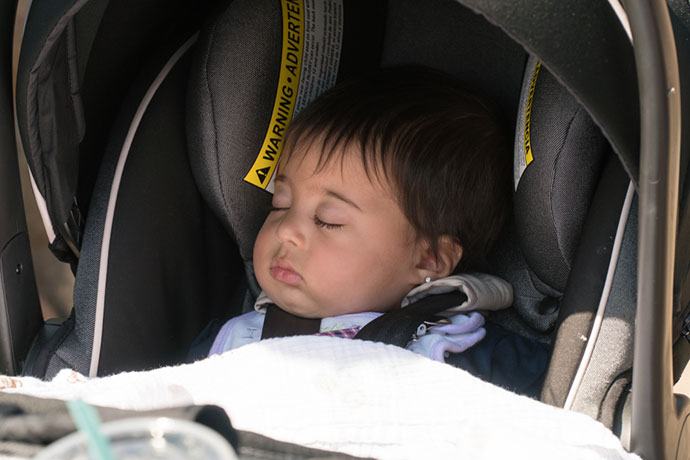
Rule number one: Not all seats fit properly into all cars.
- Most convertible seats (first used rear-facing then forward-facing for older children) are labeled for babies weighing a minimum of 5 pounds.
If your baby might be low birth weight or premature, see premature and low birth weight information below.
- Each rear-facing seat has a recline angle that must be followed when installing the seat into your vehicle.
The angle is a requirement, not a suggestion.
- Choose a seat that does not press against either of your front vehicle seat backs and does not require you to move your driver and/or front passenger seats closer to the dashboard in order to achieve the proper recline angle.
This is why trying before buying is important.
- In the lowest position, will the harness be at or below your baby's shoulders? Harness straps hold the baby down into the seat.
An average newborn's torso is about eight and one-half inches. If the harness comes above a newborn's shoulders it should not be used.
- Consider grow room. Convertible seats protect rear-facing to 35, 40 or more pounds (read labels).
Later the seat is converted to its forward-facing direction for older children.
The American Academy of Pediatrics recommends children ride rear-facing to at least two years of age or to the highest weight limit the seat permits (check the child restraint manual and labels on the seat).
Choose a seat with a harness that is easy to loosen and tighten and to buckle/unbuckle.
3. What car seats fit a premature or low birth weight baby best?
Convertible seats (rear-facing to forward-facing) are generally for full-term infants weighing 5 pounds or more.
Check instruction books and labels for lowest weight limits.
The Combi Coccoro Convertible seat is labeled for infants weighing 3 pounds or more while infant (rear-facing only) seats may begin at 4 pounds.
Select a seat with shoulder straps located 6 inches or less from the bottom of the seat.
Use the harness in lowest set of slots.
A crotch strap that is 5 ½ inches or less from the seat back will fit a small baby best.
If needed, place a rolled washcloth between the baby's crotch and the crotch strap to keep baby from slouching.
Two small rolled receiving blankets placed along the baby's body provide added support.
Never place any extra padding behind or underneath the baby.
Many hospitals follow the American Academy of Pediatrics recommendation that babies born before 37 weeks should be tested in their car seat before going home.
The test tells if heart rate, oxygen level or breathing problems will develop from car seat use.
If they do, your baby may need to ride lying down in a crash-tested car bed.
4. When can my baby ride forward-facing?
Do not be in a hurry to move your child forward-facing.
Riding rear-facing is than riding forward-facing if your child is still within the weight and height limits for the seat. Read the instruction book and the seat labels.
NEVER turn a baby forward facing before the minimum weight, height and age listed in the instruction book.
Move a baby who outgrows their infant seat into a rear-facing convertible seat.
Many convertible models can be used rear-facing to 40-50 pounds. If you have questions about a certain model, contact the manufacturer.
5. How do I know when my child has outgrown his/her infant seat?
An infant seat is outgrown when:
1. The baby reaches either the height or weight limit (which ever comes first) listed on the seat's label OR
2. There is no longer one inch of padding and seat shell above the baby's head.
Move the baby into a convertible seat that allows him/her to remain rear-facing.
Follow manufacturer’s instructions to determine when you may turn your child forward-facing.
Remember that riding rear-facing offers the best protection for your baby's head, neck and spine.
For optimal protection, the AAP recommends babies ride rear-facing in a convertible seat up to two years of age AND to the seat's highest rear-facing weight limit.
6. I have a child who is big enough now for a convertible seat. What do I need to know?
Convertible seats fit children 5 - 65 (or more) pounds depending on model.
Read instructions and labels on the side of the seat.
Choose a seat whose label specifies it has been tested for rear-facing use to a minimum of 40 or more pounds.
For optimal protection, the American Academy of Pediatrics recommends babies ride rear-facing in a convertible seat up to 2 years of age and to the highest rear-facing weight limit of their seat.
Height of the top harness strap slots varies.
Forward-facing, harness straps need to be in reinforced slots at or above the child's shoulders.
Is there enough grow room?
In some seats, only the top-most slots may be used when the seat is forward-facing.
Read and follow the directions in manufacturer's instructions.
Preschoolers & Forward-Facing Seats FAQs
1. How do I know when my child has outgrown a convertible or forward-facing only car seat?
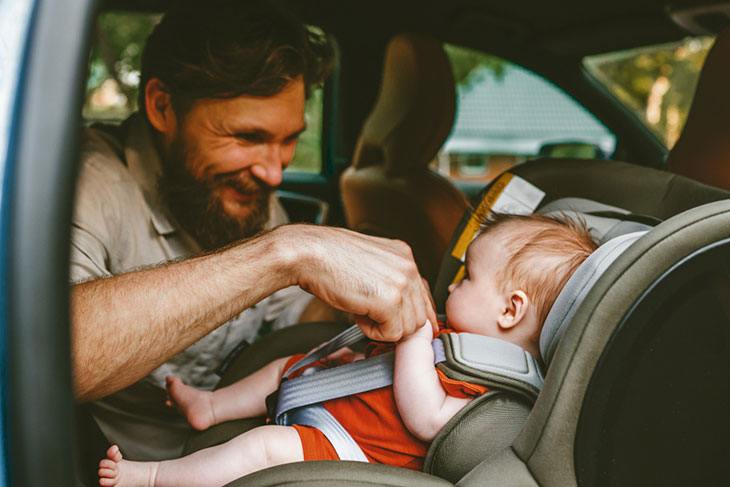
A forward-facing seat with a harness is outgrown when one of the following 3 things happens:
- The child exceeds the weight limit specified on the seat's label.
- The top of a child's ears are above the back of the child car seat.
The seat shell and pad are needed behind the child's head to provide whiplash protection.
- On most seats when the harness straps (in the top slots) are no longer at or above the child’s shoulders.
Read and follow instructions.
2. What should I do next to provide the best protection for my child?
For best protection (when a child outgrows a convertible seat) use a forward-facing only seat with a harness (sometimes called a combination or harness-to-booster seat).
These provide the protection of a harness to 70-90 pounds.
For tall/slim children, pay particular attention to the height of the highest set of harness slots.
This "seated height" (fanny-to-top-of-shoulder) varies among car seat models. Choose one that will give the child enough room to grow.
On many models of "forward-facing only" seats, the harness can be removed/stowed and the seat becomes a belt-positioning booster seat for use in vehicles with lap and shoulder belts.
Weigh and measure your child to assure child is within the minimum height and weight on labels.
Once a child exceeds the height or weight limits of their convertible or forward-facing harnessed seat, a belt-positioning booster seat should be used to properly position the adult lap and shoulder belt.
A belt-positioning booster:
1. Acts as an artificial set of adult-size hip bones
2. Positions the lap part of the adult seat belt low on the hips/across the top of the thighs keeping it off the abdomen
3. Routes the shoulder part of the belt properly across the center of the chest and shoulder.
Children & Belt-positioning Booster Seats FAQs
1. Are children 4 to 8 years of age big enough to use the adult seat belt?
NO! In a crash, children this age can be seriously injured by an adult lap and shoulder belt because it does not fit properly.
- Children of this age do not have legs long enough to bend over the edge of the vehicle seat without slouching.
- When children slouch, the lap part of the seat belt slides up onto the soft part of their abdomen.
- In a crash, a seat belt that is not worn across the hip bones causes serious injuries such as a ruptured spleen, perforated intestine, or a fractured spine.
These injuries are so common that Emergency Department doctors call them "seat belt syndrome".
Did you know?
- If the shoulder part of the belt is placed behind the child's back or under the arm, head injuries can result or the shoulder part of the belt can break ribs, puncturing internal organs.
- Children who are too small for the adult seat belt can, and have, slipped out from the lap/shoulder belt, been ejected from the vehicle killed in a crash.
- Children need the protection of a belt-positioning booster seat until they are at least can pass the 5-step test for proper adult seat belt fit.
2. How does a booster seat provide protection?
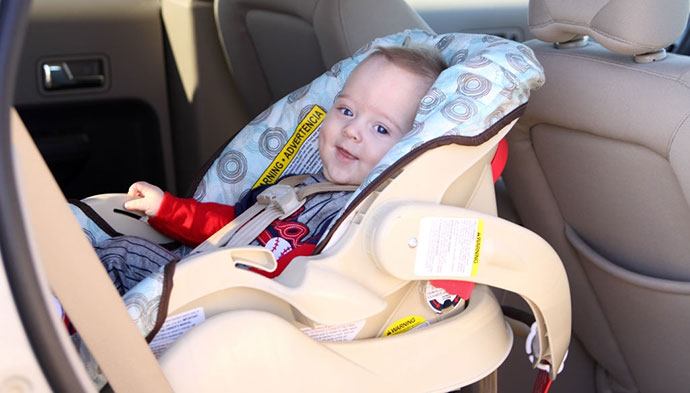
- A belt-positioning booster seat lifts the child up and into the adult seat belt to properly position it on the child's smaller body.
It gives your child a set of adult-sized "artificial hips" that keep the lap part of the seat belt off the soft tissue of the abdomen.
The “best” booster seat for your child and vehicle: places the lap belt low on the hips touching the tops of the thighs and positions the shoulder belt across the center of the chest and shoulder.
- A booster gives the child a seat that allows the child's legs to bend comfortably so the child doesn't need to slouch for comfort.
- A strap, belt guide, or clip allows the shoulder part of the belt to be adjusted properly at shoulder level as the child grows.
- High back booster seats offer support so a sleeping child is less likely to slip out from underneath the shoulder belt.
- The added height allows the child to see out the window like an adult can.
- Some booster seats can be attached to using the vehicle LATCH system (if present).
In a sudden stop or crash this prevents an unused booster from becoming a loose object inside the car.
Read and follow both the vehicle and booster seat manufacturer's instructions.
- IMPORTANT! If your car is not equipped with LATCH (or your booster can not be attached using the LATCH system) teach your child to re-buckle the seat belt around the booster so it does not strike other passengers in a crash or sudden stop.
3. Can my child use a booster if our car has only lap belts?
No! A booster seat requires both the shoulder AND the lap belt.
Even though the child will not have upper body protection, a properly worn lap belt is still better than being unrestrained.
Teach your child to wear the lap part of the belt down low on the hips, not up on the tummy.
Other options:
- Many car seat manufacturers now make products for children weighing more than 40 pounds that can be installed in vehicles with only lap belts.
If your vehicle was made before 1999 adding a tether anchor will provide an additional point of security for the car seat.
- Purchase and install a shoulder belt retrofit kit if one is available from the manufacturer of your vehicle.
Retrofitting a shoulder belt will offer the best protection not just to booster seat age children, but also to anyone who might ride in that seating position.
Not all vehicles can be retrofitted and the parts and service departments of many dealerships may not be aware that the manufacturer at one time made a kit specifically for a given year and model of vehicle.
- EZ-On manufactures the Y-Harness and EZ-On Vest.
Children weighing more than 40 pounds can use them in vehicles with a lap-only belt.
Crash tested, each meets federal motor vehicle safety standards and offers upper body protection.
Visit their website at www.ezonpro.com
4. I've heard small-shield booster seats are no longer recommended. Why?
These boosters are no longer being made and are too old for use.
Small shield boosters were originally designed for children 30-60 pounds, and were tested using a lap only belt and a dummy the size of a three-year old.
In 1996, the government's standards changed to require booster seats to be tested with a 47 pound crash test dummy the size of a six-year old child.
Manufacturers revised instructions for shield boosters to allow use of the shield only until the child weighed 40 pounds.
On some small shield booster seats, the shield could be removed and the base used as a backless belt positioning booster.
Children weighing less than 40 pounds should use a forward-facing car seat with a harness until they physically outgrow it.
Older Kids & Seat Belts FAQs
1. When is my child big enough to use the adult seat belt?
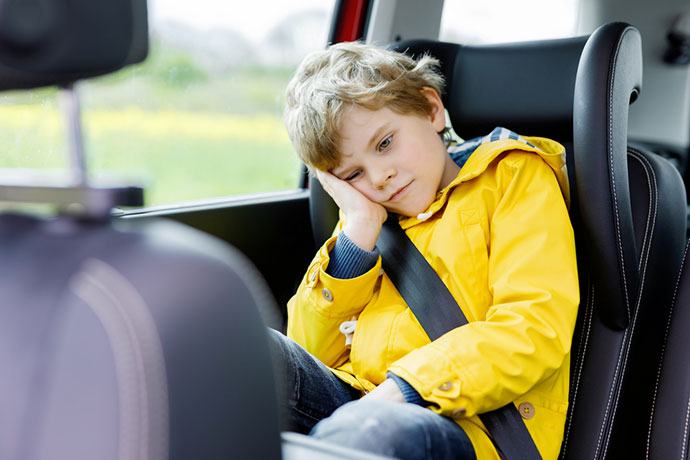
Keep using a booster seat until your child is about four feet nine inches tall.
To see if the seat belt will fit your child, answer the following questions: *
1. Does the child sit all the way back against the vehicle seat?
2. Do the child's knees bend comfortably at the edge of the vehicle seat without slouching?
3. Does the lap belt fit snugly across the top of the thighs?
4. Does the shoulder part of the belt come across the center of the shoulder and chest?
5. Can the child sit like this for the whole trip?
If you answered "NO" to any question, then the child should continue to ride in a belt-positioning booster seat.
Remember, check for good belt fit in all the cars your child rides in.
Just because the seat belt system fits your child in one vehicle does not mean that the seat belt will fit correctly in all vehicles.
You must perform this test in each vehicle your child rides in to assure proper belt fit.
2. Can I buckle two children into one seat belt?
NO, two people should never use one vehicle seat belt! In a crash, two people sharing one seat belt will collide violently.
Buckling two people into one seat belt could cause serious injury or death.
3. Is it OK for my child to put the shoulder belt behind his back or under his arm?
NO, the shoulder belt restrains the upper body.
Placing the shoulder part of the belt under the arm can break ribs causing them to injure internal organs.
Putting the shoulder part of the belt behind the back not only takes away upper body protection; it keeps the seat belt system from working properly.
In a crash, the lap part of the belt is tightened as the upper body moves forward pressing against (loads) the shoulder belt.
Placing the shoulder portion of the seat belt behind one’s back results in a loose lap belt increasing the risk of serious injury.
Check the vehicle owner's manual to see if the shoulder belt in your vehicle has an adjustable anchorage.
If not, for older child passengers, choose a booster seat that will properly adjust the belt fit.
Correct Installation FAQs
1. How do I know my child restraint may be incompatible with my vehicle or improperly installed?
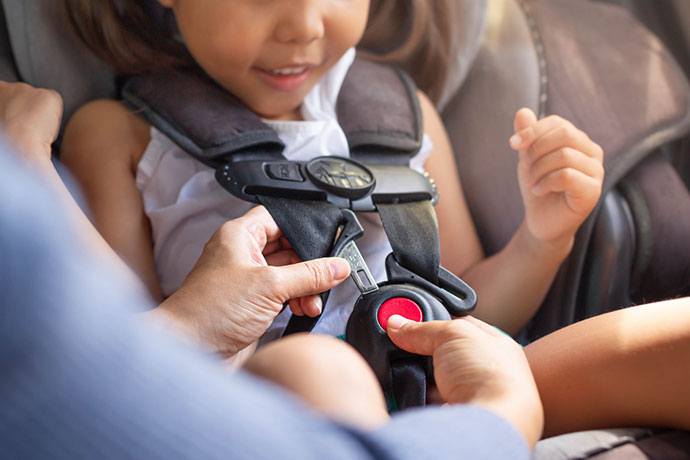
Your child restraint may be incompatible with your vehicle or improperly installed if:
- The child car seat moves more than one inch from side-to-side on your the vehicle seat cushion when pushed and pulled near where the seat belt goes through the child car seat.
- The vehicle seat belt stays loose, doesn't lock or loosens after it's been tightened.
- More than 20 percent of the seat hangs over the edge of the vehicle seat.
- Your vehicle seat does not face forward (faces the side or rear of the car).
- A newborn's head tips forward, with baby's chin on its chest.
2. My car seat moves more than one inch side-to-side even after I've tightened the seat belt. Should I buy and use one of those seat belt tightening devices?
Vehicle manufacturers explain how to properly tighten their seat belts around a child car seat.
You will find this information in your vehicle instructions.
No vehicle manufacturer advocates the use of belt tightening devices.
Car seat manufacturers also provide instructions on how to properly secure their car seat.
No child restraint manufacturer advocates the use of belt tightening devices.
Here is what two manufacturers have to say:
"While Evenflo does not have a specific note in the product instruction manual about belt tightening devices, we do state in our warnings section in every book DO NOT attach additional padding, toys or other devices not made by Evenflo or described in these instructions to the child restraint.
Items not tested with the child restraint could injure the child.
Evenflo does not sanction the use of the Mighty Tite or any other similar device with our products."
- By Randy Kiser Director, Product Safety, Research & Development Evenflo Company, Inc.
Another car seat manufacturer, Britax, says this about tightening devices:
"The use of non-Britax Child Safety, Inc. covers, inserts, toys, accessories, or tightening devices is not approved by Britax.
Their use could cause this restraint to fail Federal Safety Standards or perform worse in a crash. Their use automatically voids the Britax warranty".
3. I've heard that most car seats are not used correctly. Where can I get my child's car seat checked?
Find people who are trained as Certified Child Passenger Safety Technicians to check a child car seat's fit and installation.
Other FAQs
1. I have a child with special medical needs. Where can I learn more about securing my child in the car?
Parents, health care providers and others can learn more about protecting children with special needs on the American Academy of Pediatrics website aap.org where you will find a list of medical conditions that affect how children fit into car seats, information about child restraint options and frequently asked questions about transporting children with special medial needs.
2. What about air bags?
NEVER place a rear-facing infant in front of an active airbag.
An unrestrained child, an infant riding rear facing or a child who is out of position (for example sitting forward on the edge of the vehicle seat) can be seriously injured or killed by an inflating air bag.
Whether or not the car has air bags, the safest place for all children who are not yet 13 years old is in the rear seat.
The driver air bag is stored in the center part of the steering wheel and the passenger air bag is stored in the dashboard.
It may be in the flat area just below the windshield or in the area facing the passenger.
All cars since model year 1998 must have driver and passenger air bags. Both air bags were required in pickup trucks, SUV's, and vans starting in the 1999 model year.
Many vehicles made in the 1990's also have air bags.
Newer cars may have lower-speed air bags or "dual stage" air bags.
These may reduce injuries but still can be deadly for rear-facing infants and unbuckled or improperly positioned children.
To locate the air bags in your car read your vehicle owner's manual.
Inside the vehicle, look for a warning label on the sun visor, or for word "Air bag" or the letters "SRS", or "SIR" embossed on the dashboard.
In a crash, air bags inflate very quickly and can hit a rear-facing safety seat hard enough to kill a baby.
Infants must ride in the back seat, facing the rear of the car.
Even in the back seat, never turn your baby to face forward until he or she is at least one year of age and weighs at least 20 pounds.
If there is no room in the back seat and you have no alternative, a child over age one who rides in a forward-facing car seat may occupy the front seat.
Move the vehicle seat as far back as possible and make sure the child is correctly restrained for his age and size.
Fasten the child restraint harness snugly, or if the child uses a booster seat, make sure the child does not lean toward the dashboard.
Many sports cars and pickup trucks have no back seat or seats are too small to install a rear-facing car seat correctly.
Many recent models come have a switch that allows the driver to turn the air bag off when transporting a baby or child in the front seat.
However, manufacturers are not required to install them as standard equipment.
Older trucks or sports cars with passenger air bags may not have on/off switches.
In this case you may be able to get a switch installed. Click here for a "Request for Air Bag On-Off Switch" form.
Excerpted with permission from "Kids and Air Bags" a publication of Safe Ride News. Visit them online at saferidenews.com.
3. I can't afford a child car seat or booster. Is there somewhere I can get help?
Your doctor's office, police department, hospital, or health department may be able to direct you to a local program that can assist you in acquiring a child car seat or booster seat for your child.
4. I've lost the locking clip that came with my car seat. Where can I get another one?
Some stores who sell car seats also sell replacement locking clips.
You can also contact the car seat manufacturer, attend a car seat checkup clinic or contact your local Child Passenger Safety Team.
5. Are you Pregnant?
Now is a great time to learn how to keep you and your new baby safe in the car.
Go to a car seat safety class if one is given by your hospital, health plan or clinic.
This will help you learn about using car seats correctly from the start.
Pregnant mothers should always use a lap/shoulder belt.
Right now you are your baby's car seat.
Avoid using a lap-only belt. Push the lap part of the belt down as far as possible below your belly.
Check to make sure it stays low and snug.
If you wear a heavy coat, open it and pull it away from your belly. This helps the lap part of the seat belt fit low and snugly.
Never put the shoulder portion of the seat belt behind your back or under your arm. It should rest across your shoulder.
- Sit as far back from the steering wheel as you can.
Let others do as much of the driving as possible during the last few months of pregnancy.
Avoid unnecessary trips.
When you ride in the car, sit in the back seat using the lap/shoulder belt.
- If you are in a crash, even a minor one, get checked at a hospital emergency room.
Your unborn baby could be injured even if you do not seem to be hurt
Important Notes When Setting the Car Seats
You must install and place the car seat according to the instruction manual.
If you cannot manage to do it properly, please, call a safety technician or instructor since they can help you and guide you on how to do it properly.
Parents need to keep all children under 12 in the child passenger restraint system, in their vehicle's back seat.
You need to buckle up kids in the middle part of the back seat when it's possible; use the lap and shoulder straps because this is the safest position for them.
You mustn't place the rear-facing car seat in front, next to you, with the airbags on!
In the case of a car crash, the external forces will trigger the airbags to open, and they will smash your tiny little one into pieces. Never do that!
Finally, buckle your kids wherever you go, regardless of the trip's length, and be a great example by buckling up yourself in the vehicle!
